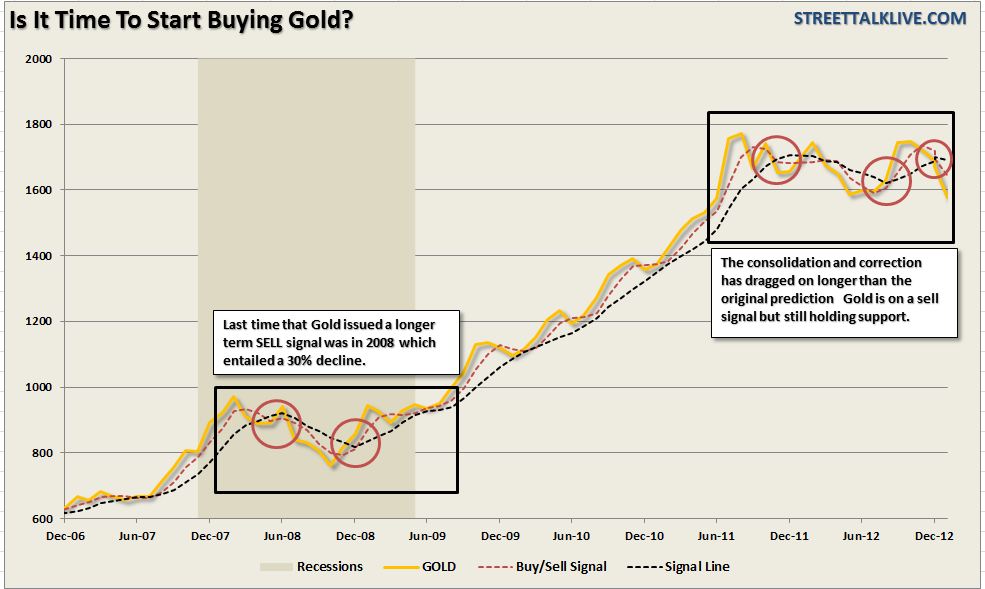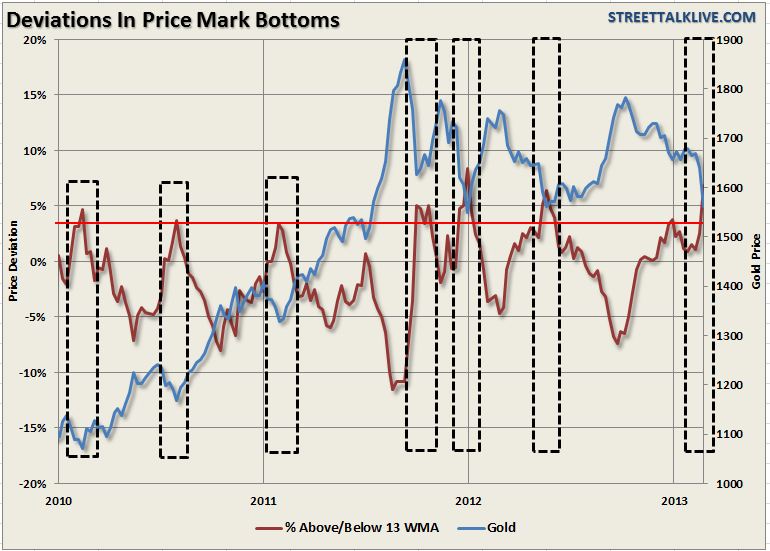
Gold has historically been considered a hedge for inflation, dollar devaluation and economic stress. Since the end of the last recession gold has been an asset class of choice by those expecting hyperinflation due to the ongoing activities by Central Banks worldwide. As for us , and our clients, gold is a commodity that should be owned when it is rising and sold when it isn’t. For us the best hedge against inflation is making sure that invested savings grow at a rate sufficient to maintain the purchasing power parity of those savings in the future. We can discuss the difference between inflation, hyperinflation and the effect of owning physical gold in a fiat currency world but that is another article entirely.
It seems like 18 months ago…wait, it was a 18 months ago, that we wrote in our weekly missive that gold had peaked after a parabolic spike stating:

Then in March of 2012, as the media began predicting the end of gold as an asset class, I wrote “Death of the Gold Bull Market” updating our August analysis wherein we discussed the consolidation process for gold before the next move higher could occur. Well, here we are today with gold pushing the lower bounds of that consolidation range and still entrenched in this long, and drawn out, 18-month consolidation process. So,the obvious question becomes, is it time to “buy?”

The first chart shows the weekly “buy” and “sell” signals. During the last recession gold had experienced a very similar parabolic price spike going into the first quarter of 2008. This spike in gold prices resolved itself over the remainder of the 2008 with a correction of 30% during the financial crisis. That consolidation process then gave way to the next major leg of the secular gold bull market. That surge was fueled by fears of hyperinflation due to successive rounds of liquidity injections by the Fed and soaring national debt levels.
As the Fed pondered the idea of entering into QE2 in the summer of 2011, combined with the fears of a debt default due to the “debt ceiling debate” at the time, gold again went into a parabolic price spike. While an actual default on U.S. debt was never actually a concern, as witnessed by the sharp drop in 10-year interest rates at the time, the fears of such an event sent gold prices spiraling higher (along with underground bunker, gun, ammo and dried food sales.) Currently, the fears over the debt ceiling, along with potential default on our debt, are of little concern to the financial markets. The chart shows that gold remains range bound within the confines of $1500 to $1700 per ounce.
As shown in the chart below – the current “sell off” in gold has much to do with the rally in the U.S. dollar, particularly as Japan has entered into an effective “currency war” by forcing yen valuations lower. Over the past decade the movements in the dollar have had a high inverse correlation with gold.
Since gold is generally a “fear” trade it is not surprising to see gold prices under pressure given the overwhelming bullish sentiment recently about the economy and the markets. However, it is likely that such optimism will be dampened by reality as the impact of the global recession weighs on the U.S. economy as I discussed recently.
This begs the question as to what will most likely cause the next rally in gold?
Catalysts For The Next Gold Surge
The following are the catalysts that could certainly send investors scurrying back into gold.
A Resurgence In The Eurozone Crisis – It has been incredibly quite in the Eurozone since last summer when Draghi made his “do whatever is necessary speech.” However, while the crisis has seemingly been quelled there has actually been very little done to fix the issues that had previously sunk the Eurozone into its crisis. As we have discussed previously in much more detail – Germany is the lynchpin for Europe and with a large majority of the German population against further bailouts, the economy slipping into a recession and Angela Merkel up for re-election this year, it is likely that the things could potentially come to a head once again. A resurgence of the debt crisis could well fuel fears of a breakdown in the global financial system pushing gold prices higher.
Stock Market Declines By 20%
The stock market will have another correction sometime this year with my best guess being sometime this summer – if not sooner. The markets are currently extremely overbought and complacency is exceptionally high. These are the catalysts necessary for a meaningful short term correction of 10-20% just as we have seen over the past three summers. While the market has been pushing higher with the expansion of the Fed’s balance sheet, of which there is an 85% correlation, the economic underpinnings remain very weak. Therefore, any reduction in the liquidity injections, of hints from the Fed that QE programs will wind down, could send investors scurrying out the markets and into gold for a “safe haven” play.
Economy Slows To Near Recession
The fear of a recessionary economy, or worse, is a “gold bugs” best friend. There have been plenty of stories about how the economy is going to ultimately collapse and the dollar will fall to zero because of the rising debt and deficit spending of the government. While economic growth is most definitely impacted by the high debts – the “End of America” is not coming anytime soon.
However, as stated above, it is the “fear” of these events that drive individuals into buying gold as a hedge against the demise of the economy and the collapse of the U.S. currency. The economy is already running at a very weak pace and any impact from a misstep in fiscal policy, or an early withdrawal of monetary policy, could well push the economy close to, or into, a recession. In such an event gold will be viewed as a hedge against economic ruin.
Time to buy gold now?
As stated above, for us, owning gold is really more of an issue of technical analysis versus some fundamental underpinning or “emotional fear” of economic collapse. Therefore, the question of whether to buy gold now, or wait, is simply of function of what the overall market thinks about it. Prices really tell us all we need to know about a chunk of inert metal. For the gold bugs, let me clear, I am not dismissing the potential for economic crisis in the future that could send prices soaring. However, between now and that future event, there is the possibility of a large price decline that I care not to participate in.
Therefore, from a technical standpoint, gold is getting to a place where a potential trading opportunity may occur. Historically speaking, when the price of gold has gotten more than 4% below the average price (inverted to display a positive number to display better) it has been consistent with a near term bottom in gold prices. With gold now 6.7% below is 13-week moving average – the risk/reward opportunity appears to be favorable for at least a short term trade. However, what investors should not be doing at this point is panic selling into this slide. With gold on a very serious “sell” signal counter-trend rallies should be used to reduce excessive weightings in gold until the overall trend becomes positive.

The second chart shows gold prices on a weekly basis going back to 2000 compared with 2- and 3-standard deviations from the 34-week moving average.














